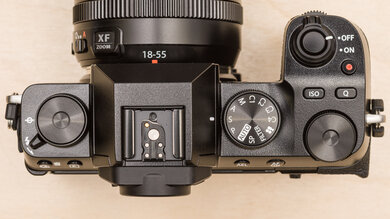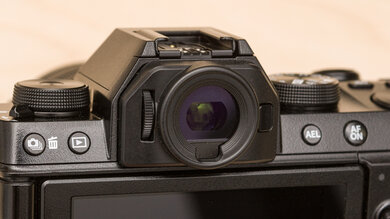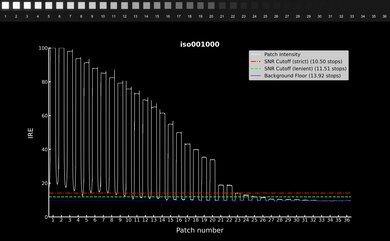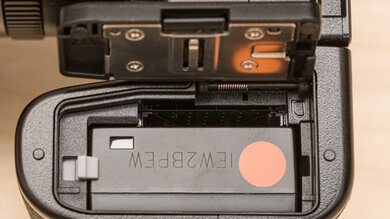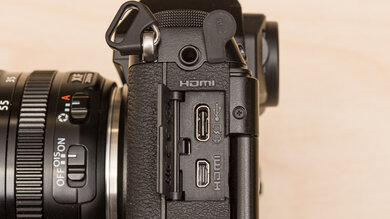The Fujifilm X-S10 is a mirrorless crop-sensor camera. It delivers great image quality and records reasonably sharp, detailed video in both 4k and FHD, though you may notice some noise when shooting in dimly lit environments. Its in-body image stabilization feature also helps smooth out camera shake in both still photography and video. It's comfortable to use, feels impressively well-built, and has a bright, sharp, fully-articulated screen, along with a wide assortment of ports for using accessories. While its autofocus performance in video is fantastic, it has a hard time maintaining focus on subjects when used for still photography.
Our Verdict
The Fujifilm X-S10 is good for travel photography. It delivers impressive image quality out-of-the-box, with minimal amounts of noise even at moderately high ISO levels. The Fujifilm Simulation modes can help give your shots a bit of added flair, though we don't currently test the camera with these modes enabled, and you can only apply them to JPG files. It features a very wide shutter speed range to help you capture both quick moments or take complex long-exposure shots. It's also comfortable to use for the most part and feels impressively well-built. Unfortunately, depending on your usage habits and choice of settings, its single-charge battery life might be insufficient for a long day of shooting.
-
Impressive image quality.
-
Sturdy-feeling construction.
-
Comfortable to use.
-
Great overall stabilization performance.
-
Mediocre battery performance.
-
Middling photo autofocus performance.
The Fujifilm X-S10 is a very good option for landscape photography. Image quality is great overall, with excellent noise handling capability even at higher ISO levels, which is good if you plan on shooting in darker environments. The built-in Fujifilm Simulation modes also allow you to give your shots a distinctive look; be aware that you can only apply them to JPG files, and we don't currently test the camera with these modes. Its fully-articulated touchscreen allows you to easily shoot from above your head or below the hip and is bright enough to be easily seen even under direct sunlight. It isn't too difficult to carry around for extended shooting sessions and feels very well-built, though it isn't weather-sealed. However, we don't currently test for that.
-
Impressive image quality.
-
Sturdy-feeling construction.
-
Comfortable to use.
-
Bright, fully-articulated touchscreen.
-
Mediocre battery performance.
-
Not advertised as being weather-sealed.
The Fujifilm X-S10 is decent for sports and wildlife photography. When using its electronic shutter, it can capture up to 20 shots per second without a crop. This, combined with its fast max shutter speed, should help you capture clear stills of fast-moving subjects, like cars on a track. Image quality is great, too, even at fairly high ISO levels. It feels well-built and is quite comfortable to operate as well. Unfortunately, its autofocus system can have a hard time tracking the movement of some subjects and, depending on your usage habits and choice of settings, battery performance is unimpressive.
-
Impressive image quality.
-
Comfortable to use.
-
Great overall stabilization performance.
-
Mediocre battery performance.
-
Middling photo autofocus performance.
The Fujifilm X-S10 is a great option for vlogging. Its fully-articulated touchscreen allows you to monitor your recording even when the camera is pointed at you, and it isn't too fatiguing to carry around. Its ergonomic grip also makes it a little easier to hold while vlogging compared to some other models in Fujifilm's model lineup. Its in-body image stabilization, combined with the FUJINON XF 18-55mm F2.8-4 R OIS kit lens' optical stabilization feature, helps the camera do an impressive job of smoothing out camera shake in both FHD and 4k video. Video quality is also good in either resolution, though you may notice some noise when shooting in dimmer environments. Its autofocus system is remarkably effective in terms of tracking subjects' faces, too.
-
Sturdy-feeling construction.
-
Bright, fully-articulated touchscreen.
-
Exceptional autofocus performance in video.
-
Great overall stabilization performance.
-
Mediocre battery performance.
The Fujifilm X-S10 is great for studio video. Video quality in FHD and 4k is sharp and detailed overall, though you may notice some graininess when recording in dimly-lit environments. It supports F-Log shooting for an expanded dynamic range in video and allowing for in-depth color grading in editing, though we don't currently test this function. While it's only capable of shooting 8-bit 4:2:0 color video internally, it can output 10-bit 4:2:2 color video through its HDMI port, which you can take advantage of by using an external recorder. It features dedicated headphone and microphone jacks too. You can also charge it over USB while in use, which is good for extended recording sessions.
-
Wide selection of inputs and outputs.
-
Exceptional autofocus performance in video.
-
Basic guide mode for menu system.
The Fujifilm X-S10 isn't for action video. It's too big to be mounted on a chest or helmet and isn't rated as being water or impact-resistant, though we don't currently test that. It's also incapable of shooting natively at more than 60 fps in FHD and 30 fps in 4k, though it does have dedicated slow-motion recording modes for FHD video. Its in-body image stabilization and kit lens' optical stabilization features also reduce camera shake by an impressive amount.
-
Sturdy-feeling construction.
-
Great overall stabilization performance.
-
Mediocre battery performance.
-
Not advertised as being weather-sealed.
-
Too big to be mounted on a chest or helmet rig.
The Fujifilm X-S10 has good RAW image quality. Its sensor has a good amount of dynamic range, so it can capture high-contrast scenes with quite a bit of detail. It has a high resolution to resolve a great amount of fine detail. However, its low light noise handling is just decent.
-
Good dynamic range.
-
Images look sharp and detailed.
-
Noise handling in low light isn't the best.
- 7.7 Travel Photography
- 7.8 Landscape Photography
- 7.5 Sport & Wildlife Photography
- 7.8 Vlogging
- 7.8 Studio Video
- 5.6 Action Video
Performance Usages
- 7.7 Raw Photo
Changelog
-
Updated Feb 10, 2025:
We wrote text for the new tests added in Test Bench 0.13.
- Updated Feb 03, 2025: We've converted this review to Test Bench 0.13. We've added new tests for Video Dynamic Range and Luminosity Patch Detection. You can learn more about these updates in the changelog.
- Updated Jan 29, 2024: Added text to 'Raw Photo Performance' verdict box.
- Updated Jan 29, 2024: Converted to Test Bench 0.12.1.
- Updated Aug 14, 2023: We've updated the sensor type to 'BSI CMOS' to reflect the sensor's back-illuminated design. We previously only noted that it was a 'CMOS' sensor.
Check Price
Differences Between Sizes And Variants
The Fujifilm X-S10 is only available in one color scheme: 'Black,' and you can see its label. We tested it in conjunction with the FUJINON XF 18-55mm F2.8-4 R OIS lens, though you can also buy it without a lens at all.
Let us know in the comments if you come across another variant of this camera, and we'll update our review.
Compared To Other Cameras
The Fujifilm X-S20 offers some notable improvements over the Fujifilm X-S10 but also sits at a higher price point. Both cameras use the same sensor and deliver comparable image quality, and both have in-body image stabilization and comfortable ergonomics. However, the X-S20 has a new processor, improved autofocus, a bigger battery, and enhanced video capabilities.
The Fujifilm X-S10 and the Fujifilm X-T30 II are both great starter cameras. They both use the same sensor, so the image and video quality is comparable. That said, the X-S10 is more suited to vlogging and video work because of its fully articulated screen and in-body image stabilization, while the X-T30 II is more portable and has different ergonomics, with dedicated exposure dials and a tilting screen.
The Fujifilm X-S10 and the Sony ZV-E10 are both aimed at vloggers, but the Fujifilm is slightly more well-rounded. Get the Fujifilm if you need in-body image stabilization and like to have the option to shoot through a viewfinder. However, if battery life and portability are priorities, the Sony is still a great option.
The Sony α6600 and the Fujifilm X-S10 are both APS-C mirrorless cameras that perform similarly overall. Both cameras have IBIS and deliver excellent out-of-camera JPEGs, although the Fujifilm offers several film simulation profiles to help you play with the look of your photos in-camera. The Fujifilm camera has better RAW noise handling performance at higher ISO settings for low-light situations. That said, the Sony camera has a more consistent and reliable autofocus system, a larger EVF, and a significantly longer battery life. It's also weather-sealed against moisture and dust.
The Sony ZV-1 and the Fujifilm X-S10 are both well-suited to vlogging, but they're also different camera types. The Fujifilm is an interchangeable lens camera with an APS-C sensor, so it's more versatile and delivers better overall image and video quality. It also has better internal video recording capability, meaning it can output higher-quality video files for more advanced video work. That said, the Sony camera's compact form factor and convenience make it a good alternative if you just want something portable for walk-and-talk vlogging.
Test Results
If you're looking for something a little more portable for vlogging, check out the Sony ZV-E10.
- Mainly made of plastic, but top and bottom plates are made of magnesium alloy
- Handgrip has a rubberized coating
- Dials rotate smoothly and have a nice-feeling outer texture
- Buttons are small, but are clicky and offer good physical feedback
- Solid-feeling screen and flash mechanisms
- Battery and SD card compartment covered by a locking hinged door
- Input and output compartment is covered by a solid locking hinged door
- Eyecup is wobbly, though this could be unique to our test unit
- Rubberized grip is deep enough to be well-suited for a wide variety of hand sizes
- Easy to change ISO, shutter speed, and aperture with your eye pressed against the viewfinder thanks to dedicated controls
- Thumb stick makes it easy to navigate the menu or choose your focus point
- Menu/OK and DISP/Back buttons lay flat against the body, making it hard to locate them when shooting in selfie mode
- ISO and Q Menu buttons on top of the camera are hard to reach for users with small hands
- Left dial switches between built-in film simulation modes but can be remapped to another more commonly-used function
- Hard rubber eyecup doesn't protrude very far and can be consequently uncomfortable to rest your eye against
- Joystick allows for quick and easy menu system navigation
- You can customize function of the buttons and swipe gestures for the touchscreen
- Q Menu lets you access commonly used parameters and can be customized to add or remove certain functions
- Some brand-specific terminology for certain features
- Unlike the Fujifilm X-T30, there's a built-in guide mode, but it's quite limited overall, with some functions not being explained at all
Note: Using the electronic shutter allows you to fire at up to 30 fps, but doing so incurs a crop on your image. Also, shooting at 20 fps with the electronic shutter lowers the JPEG buffer size to 56 shots and increases the buffer clearing time from '0s' to '7.45s' compared to the results shown, which we achieved with the mechanical shutter.
If you're looking for a camera with internal 10-bit 4:2:2 recording, consider the Fujifilm X-S20.
Update 06/23/2021: We've updated the frame rates for this camera. Like the Fujifilm X-T4, the X-S10 is capable of recording high-speed FHD video in 120 fps and 240 fps, but it only allows for playback of this footage in 10x, 8x, 4x, or 2x slow motion speed. It can't actually playback this footage at high speed, and it doesn't record sound in this mode, either. This feature is available in the 'Full HD High Speed Rec' menu (see here and here). Enabling this feature also incurs a crop.
The camera has excellent video dynamic range. It captures a very wide range of detail above the background noise floor, and even using stricter SNR thresholds, it still records a very wide ratio of highlight to shadow detail. That means you'll have plenty of usable dynamic range to work with.
Tested settings:
- Resolution: 4k
- Frame Rate: 30 fps
- Log Format: F-Log
The Fujifilm X-S10 allocates more dynamic range in the shadows than the highlights, so you'll have a bit more range and flexibility with darker parts of the image. Still, its dynamic range stays quite consistent across most ISO settings.
Tested settings:
- Resolution: 4k
- Frame Rate: 30 fps
- Log Format: F-Log
Comments
Fujifilm X-S10: Main Discussion
Let us know why you want us to review the product here, or encourage others to vote for this product.
Update: We wrote text for the new tests added in Test Bench 0.13.




